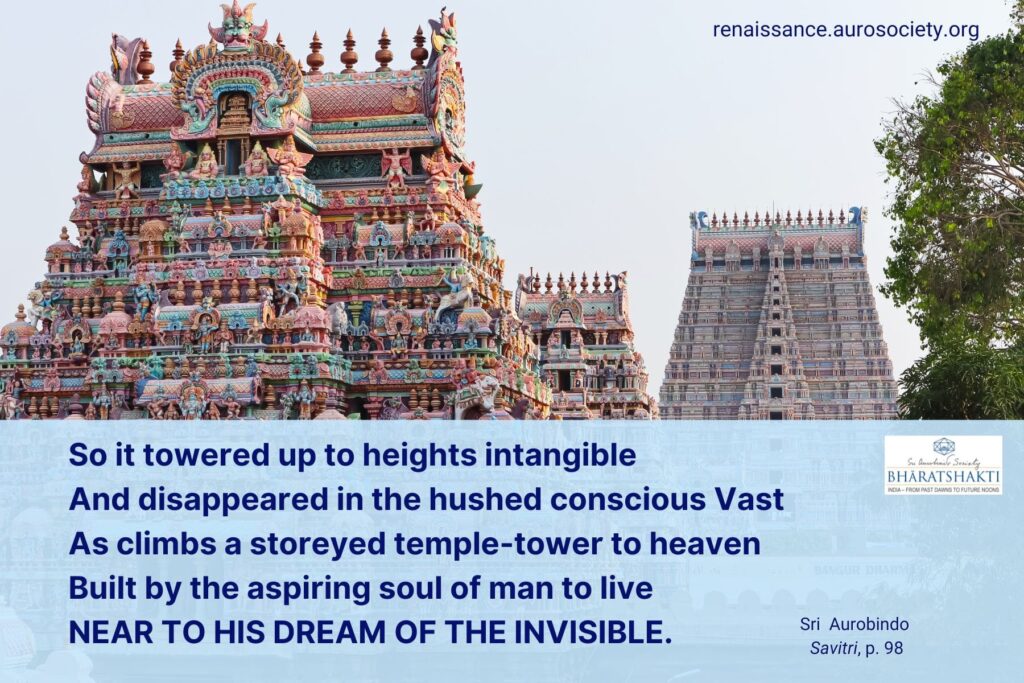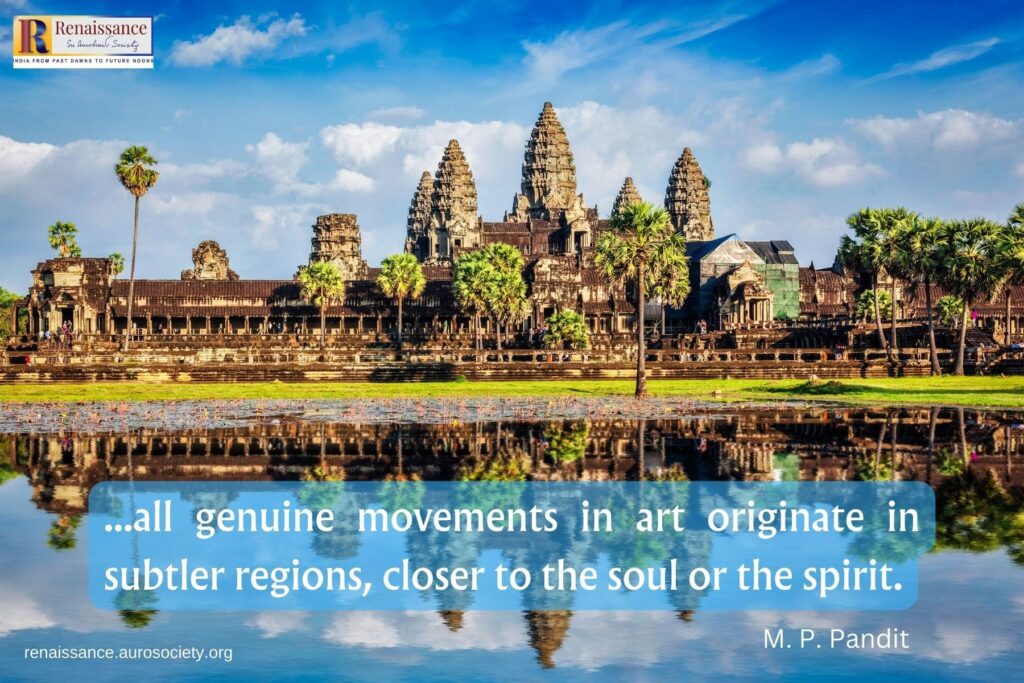Volume V, Issue 3
Author: Sri Aurobindo
***
Editor’s Note: We feature two passages from Sri Aurobindo’s writings that help us deepen our understanding of the phrase वासुदेवः सर्वमिति from the Bhagavad Gita (7.19). One passage is from Essays on the Gita, and other from his commentaries on Isha Upanishad where he connects the idea, “The Lord is everywhere; the Lord surrounds everything with His presence; the Lord is all” with the practice of Karmayoga.

From Essays on the Gita
. . . vāsudevaḥ sarvam iti; the Godhead is all that is universe and all that is in the universe and all that is more than the universe.
The Gita lays stress first on his supracosmic existence.
For otherwise the mind would miss its highest goal and remain turned towards the cosmic only or else attached to some partial experience of the Divine in the cosmos.
It lays stress next on his universal existence in which all moves and acts.
For that is the justification of the cosmic effort and that is the vast spiritual self-awareness in which the Godhead self-seen as the Time-Spirit does his universal works.
Next it insists with a certain austere emphasis on the acceptance of the Godhead as the divine inhabitant in the human body.
For he is the Immanent in all existences, and if the indwelling divinity is not recognised, not only will the divine meaning of individual existence be missed, the urge to our supreme spiritual possibilities deprived of its greatest force, but the relations of soul with soul in humanity will be left petty, limited and egoistic.
Finally, it insists at great length on the divine manifestation in all things in the universe and affirms the derivation of all that is from the nature, power and light of the one Godhead.
For that seeing too is essential to the God-knowledge; on it is founded the integral turn of the whole being and the whole nature Godwards, the acceptance by man of the works of the divine Power in the world and the possibility of remoulding his mentality and will into the type of the God-action, transcendent in initiation, cosmic in motive, transmitted through the individual, the Jiva.
The supreme Godhead, the Self immutable behind the cosmic consciousness, the individual Divinity in the human being and the Divine secretly conscious or partially manifested in cosmic Nature and all her works and creatures, are then one reality, one Godhead. But the truths that we can put forward the most confidently of one, are reversed or they alter their sense when we try to apply them to the other poises of the one Being.
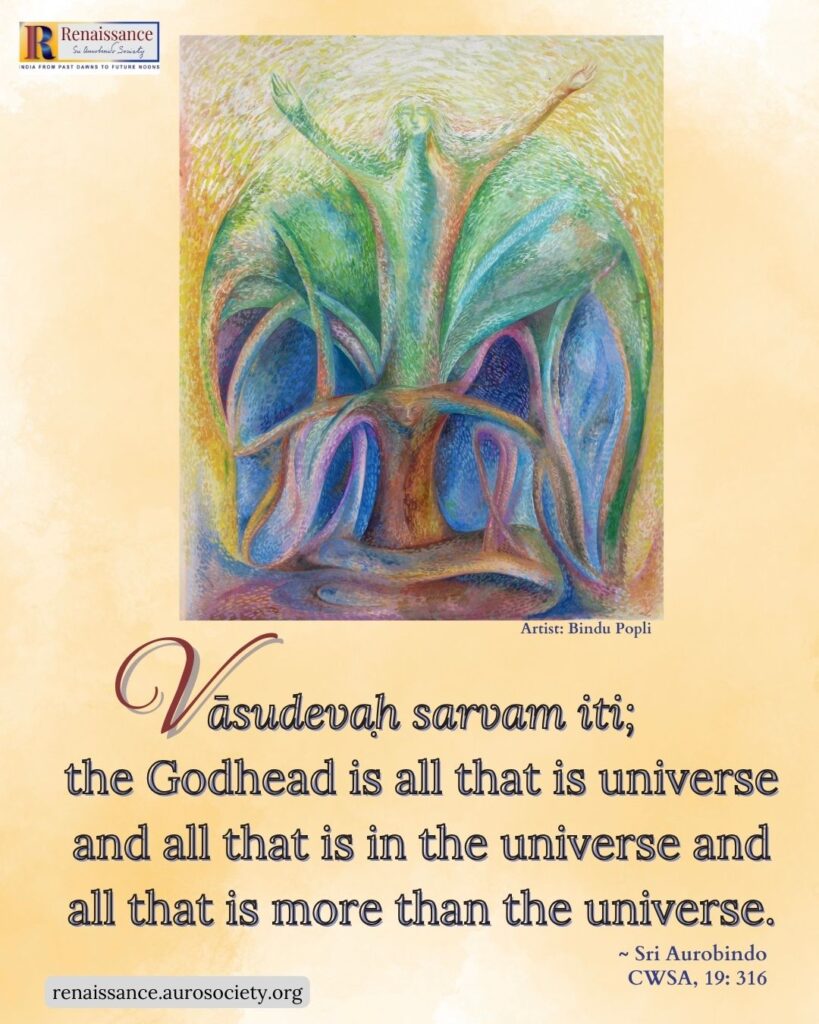
Thus the Divine is always the Lord, Ishwara; but we cannot therefore crudely apply the idea of his essential lordship and mastery in exactly the same way without change in all four fields.
As the Divine manifest in cosmic Nature he acts in close identity with Nature.
He is himself then Nature, so to speak, but with a spirit within her workings which foresees and forewills, understands and enforces, compels the action, overrules in the result. As the one silent self of all he is the non-doer, and Nature alone is the doer.
He leaves all these works to be done by her according to the law of our being, svabhāvas tu pravartate, and yet he is still the lord, prabhu vibhu, because he views and upholds our action and enables Nature to work by his silent sanction. He by his immobility transmits the power of the supreme Godhead through the compulsion of his pervading motionless Presence and supports its workings by the equal regard of his witness Self in all things.
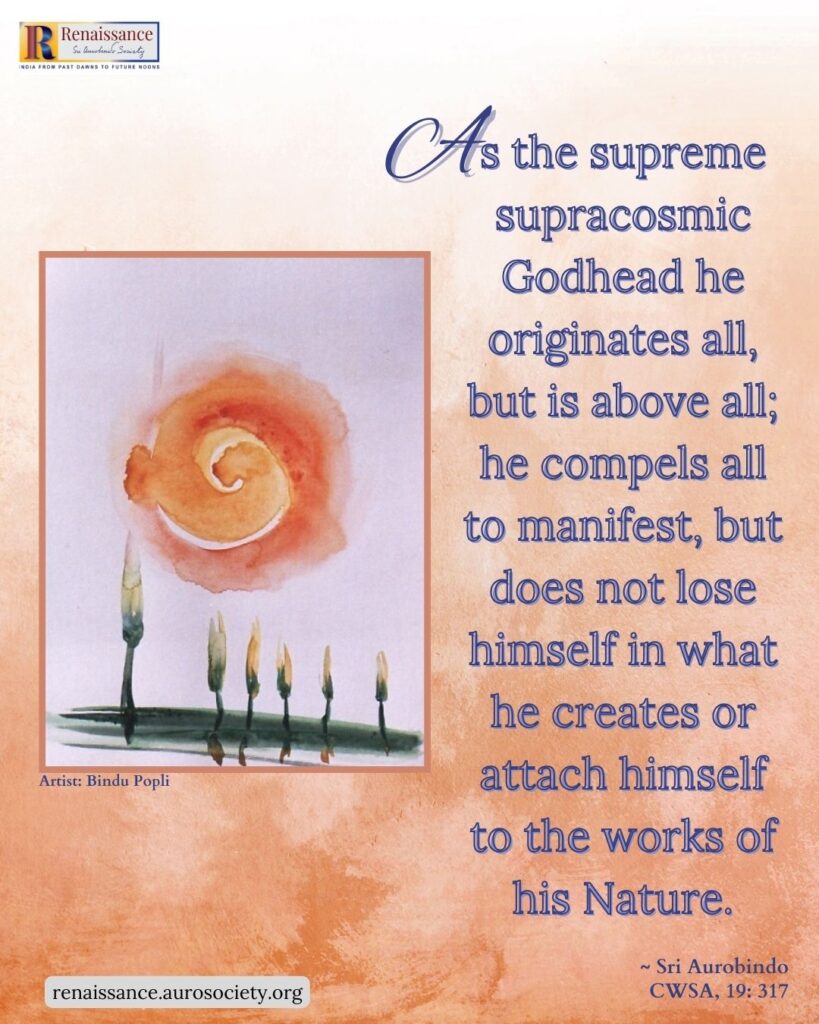
As the supreme supracosmic Godhead he originates all, but is above all; he compels all to manifest, but does not lose himself in what he creates or attach himself to the works of his Nature. His is the free presiding Will of being that is antecedent to all the necessities of the natural action.
In the individual he is during the ignorance the secret Godhead in us who compels all to revolve on the machine of Nature on which the ego is carried round as part of the machinery, at once a clog and a convenience. But since all the Divine is within each being, we can rise above this relation by transcending the ignorance.
For we can identify ourselves with the one Self supporter of all things and become the witness and non-doer.
Or else we can put our individual being into the human soul’s right relation with the supreme Godhead within us and make it in its parts of nature the immediate cause and instrument, nimitta, and in its spiritual self and person a high participant in the supreme, free and unattached mastery of that inner Numen.
This is a thing we have to see clearly in the Gita; we have to allow for this variation of the sense of the same truth according to the nodus of relation from which its application comes into force. Otherwise we shall see mere contradiction and inconsistency where none exists or be baffled like Arjuna by what seems to us a riddling utterance.
* * *
From Isha Upanishad
The [Isha] Upanishad first sets forth the universality of the Supreme Being; whatever we see, hear or are in any way sensible of, we must feel the presence of the Lord surrounding it. This tree that I am sitting under, I must not consider as only so many leaves, bark, pith, sap and roots encased in earth and air; I must realise that it is a manifestation in the Supreme who is the only reality. This voice that I am uttering, vibrates in the atmosphere of the Divine Reality; only because it vibrates there, is it capable of sound, articulation and meaning.
No action I do or watch others do, but the Lord is there surrounding and upholding it; otherwise it could not be done. Whatever I see, I am seeing God; whatever I hear, I am hearing God; whatever I do, it is the Energy of God which is governing my actions. This is the first thing the Karmayogin has to realise and until he has set his mind on the realisation, Karmayoga is impossible.
The Lord is everywhere; the Lord surrounds everything with His presence; the Lord is all. वासुदेवः सर्वमिति ।
This Karma that I do, I do it in the Lord; this subjective I who act, exist only in the Lord; this objective he, she, it to whom the action is done, exists only in the Lord. It is the omnipresent universality of the Supreme, that has first to be realized.
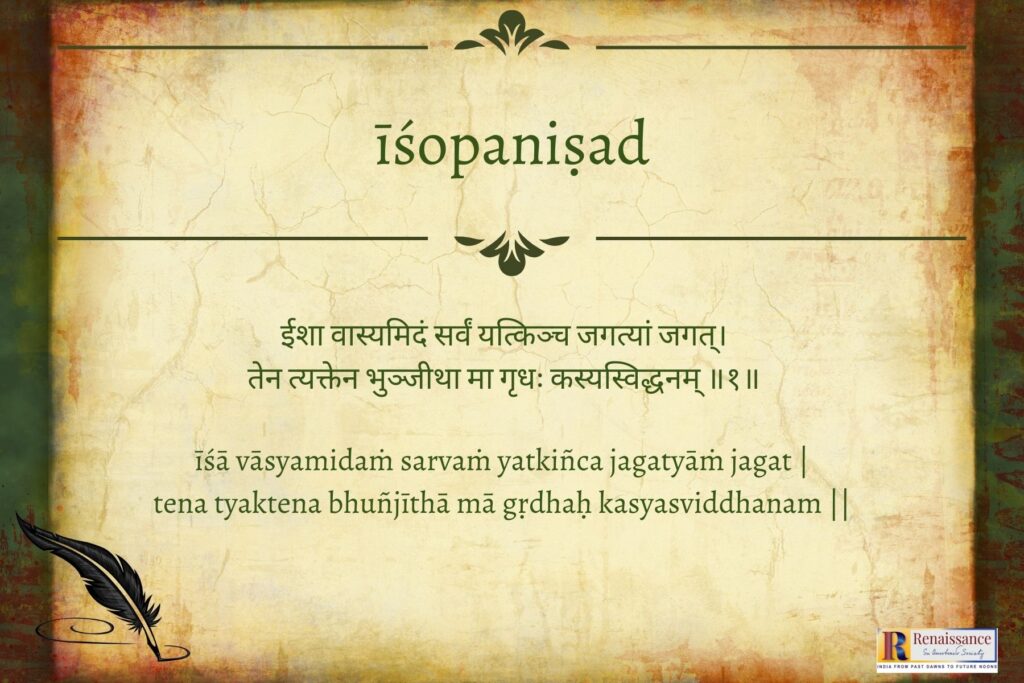
When the Yogin has had spiritual experience of this universality, then only is he fit for Karmayoga; for not till then can he sink the constant feeling of I and thou and he in a single higher and wider Existence; not till then can he escape from apparent self to true Self, and without such escape Karmayoga cannot really begin.
To clothe all things with the Supreme, to be conscious of Him in all you say, do, think, feel or are sensible of,—this experience is the beginning of Karmayoga. The transformation of this experience into the habitual condition of the soul, is the consummation of Karmayoga; for it leads straight to the knowledge of Brahman and the ecstasy of union with Him, Karma melting into and becoming one with Jnana and Bhakti.
[…]
All this Universe must be clothed with Isha; we must draw the feeling of His presence round every object in the Universe and envelop it with Isha, as a robe is drawn round and envelops the wearer. For the Lord is greater than His universe.
This tree is not the Lord, it is in the Lord.
We must avoid the materialistic Pantheism which identifies the visible Universe with the Supreme Being. It is true that He is both the final and material Cause of the universe, and in one sense He is His Universe and His Universe is He, just as Shakespeare’s creations are really Shakespeare himself, woven by him out of his own store of psychic material; and yet it would be obviously a mistake to identify, say, Iago with Shakespeare.
This tree is evolved out of original ether, ether pervades it and surrounds it, but the tree cannot be described as ether, nor ether as the tree; so, going deeper down, we find it is evolved out of the existence of the Lord who pervades it and surrounds it with His presence; but the tree is not the Lord, nor the Lord the tree.
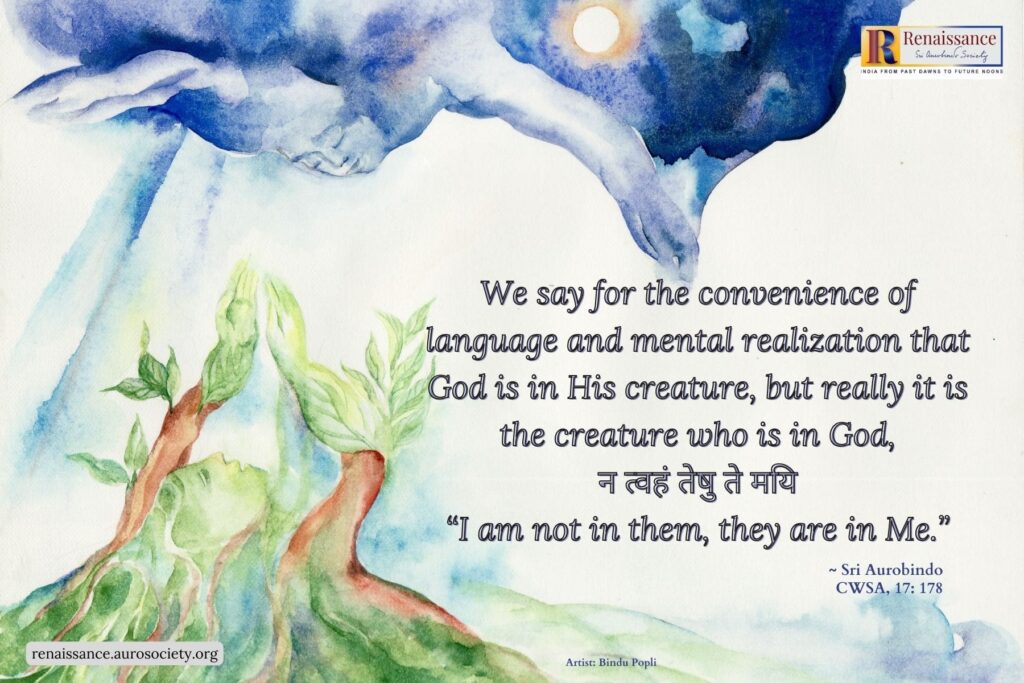
The Hindu is no idolater; he does not worship stocks or stones, the tree as tree or the stone as stone or the idol as a material thing, but he worships the presence of the Lord which fills & surrounds the tree, stone or idol, and of which the tree, stone or idol is merely a manifestation or seeming receptacle. We say for the convenience of language and mental realization that God is in His creature, but really it is the creature who is in God, न त्वहं तेषु ते मयि. “I am not in them, they are in Me.”
~ Design: Beloo Mehra
Also read:
God at the Beginning, God in the Middle, God at the End, God Everywhere
~ Paintings: Bindu Popli; Design: Beloo Mehra


